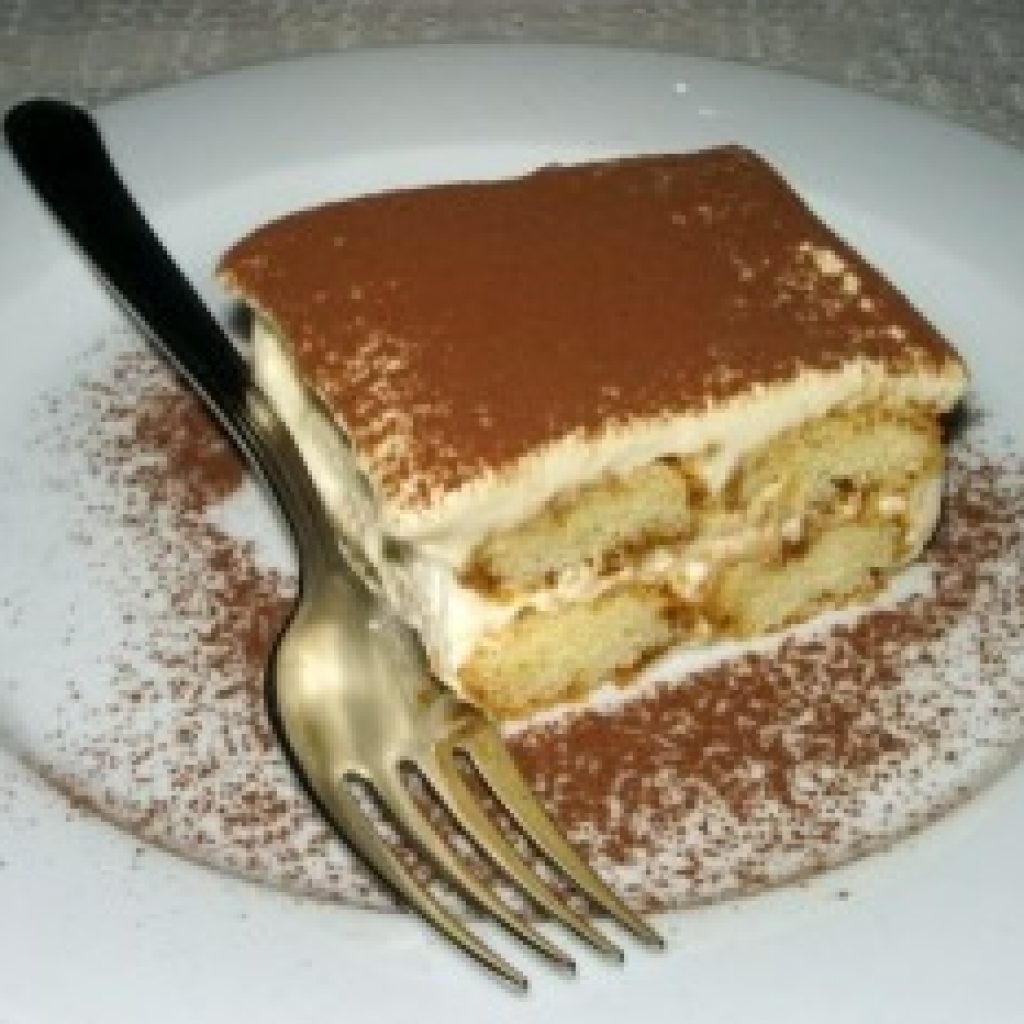It is not hot-off-the-press news that Italian food is delicious. There is, after all, a reason that it has spread throughout the world as a popular cuisine that is healthy, tasty and simple.
And sometimes the history behind the actual recipes is almost as interesting as the great dishes themselves.
Take Tiramisu for example. This great sweet, which translates to ‘Pick Me Up’, is a traditional Tuscan sweet – according to Tuscans anyway. Ask around in Venice and they will swear it is from the Veneto region. And if you have a lot of time on your hands, and ask around in the Piemonte region, and you’re likely to hear those Tuscan and Venetian claims be totally disparaged.
Tiramisù, as we hope for your own taste buds’ sake that you have experienced for yourself, is a soft cake-like dessert that is made with coffee, and requires no baking. It is simple to make, delicious to eat, keeps well the day after (and if it weren’t so lick-the-bowl-clean good, we may have been able to discern if it were good even after that).
As to the Tuscan history of Tiramisù, legend has it that it was decided to make a cake in honour Cosimo III de’ Medici, as Grand Duke of Tuscany. The occasion was that the Grand Duke was visiting Siena for a few days, which at that time was a great reason for making a new dessert in his honour*.
Wanting to please the Medici rulers of Florence, as most did at that time (well, except those fellows who tried to kill the poor Medici monarchs), it was wisely decided to create a great dessert that was however elegant, combing simple ingredients to make a dessert that was also conveniently easy to prepare. They did well, because the dessert was well received by not only the Duke, but the entire court soon thereafter. Whilst initially named in honour of the Duke, with the not-so-appetising name that translates to something like ‘Duke Soup’, it was soon given the title of Tiramisù – ‘pick me up’, owing to the sugar and caffeine in the dessert.
Nice story, right? If only it were true, say the Venetians.
Those in the region of Venice claim that Tiramisù was invented by the El Toula restaurant in Treviso who created the world-famous Italian dessert recipe. Given the proximity to this restaurant to a, ugh-um, house of risqué trade , their clientele found that this dessert really, well, did the trick.
As to Turin in the Piedmont region, they claim that Tiramisù’s origins are much more noble. Their version of the history of Tiramisù claims that this delicious dessert recipe was created in honour of a Count in order to lift his sprits after he had been severely tested in his attempts to unify Italy. Thus, Tiramisù developed as a moral lifter for the Count. With a name almost as long as the history of Italy itself, Count Camillo Paolo Filippo Giulio Benso (1810-1861), was the Count of Cavour, of Isolabella and of Leri.
When trying to discern the origins of something like a traditional Italian recipe, there is one method which can be either considered to be either a quite dubious or shore-fire way. This means is the bane of most native English-speakers, yet thanks to the diversity of dialects around Italy, to Italians it can hold the key to one’s origins. We are speaking of course, about grammar. The term Tiramisù, coming from pick (tira) me (mi) up (su), can be said to rule out Tuscan origins as at the time when Tiramisù first surfaced, the Tuscan dialect did not include such usage of reflexive verbs.
Leaving history and grammar aside, below we have the simple and delicious Tiramisù recipe below. Since its creation, Tiramisù has become a popular sweet treat around the world. It has varied a little, with some adding alcohol, some using different kinds of biscuits, and with quantities changing. Below is one typical Italian recipe for the great sweet, Tiramisù by Tessa Kiros from her great Italian cookbook, Venezia: Food & Dreams.
TIRAMISU’
By Tessa Kiros
(From Venice: Food & Dreams)
3 fresh eggs, preferably organic, separated
3 heaped tablespoons sugar
250 g (9 oz) mascarpone
About 125 ml /4 fl oz/ half a cup) strong coffee
About 3 tablespoons rum, cognac or kirsch
About 30 Pavesini or small Savoiardi biscuits
Unsweetened cocoa powder for dusting
Serves 6
This can be varied as much as you like: make it less sweet, more sweet; serve it with gratings of dark chocolate on the top; use whatever alcohol you like, such as grand marmier, whisky or marsala. It’s also very easy to make double the amount.
My friend Claudia makes this for the children with no alcohol. She mixes milk with the coffee for a lighter version.
You can either make this in individual dishes or one large one. Small dishes need to be about 5 cm (2 inches) high and long enough across the base to fit the biscuits so at least 7 cm (2 ¾ inches). I prefer individual ones but if you’d like to make this in one large dish, it should be about 26 x 18 cm (10 x 7 inches) and 5 cm (2 inches) deep. Mine is slightly larger at the top so I usually have to add more biscuits to the top layer than I did to the bottom.
– Whip the egg whites until they are fluffy and white. Next, (you don’t need to wash the beaters) whip the egg yolks and sugar for an age in a bowl until it is as creamy as you think it will ever get. Mix in the mascarpone and give a quick whisk, then fold in the egg white until lovely, full and voluminoso.
– Make your coffee (if you’re using a moka, listen for a beautiful ‘ready’ sound). Pour the coffee into a bowl (if you like, stir in 1 teaspoon of sugar to sweeten it). Allow to cool a little, then splash in your alcohol.
– Have your 6 dishes ready and dollop a tablespoon of mascarpone into each bowl. Dip a couple of biscuits at a time into the coffee until they have soaked it up, then shake them out well so any excess coffee drips back into the bowl and you don’t end up with soggy biscuits. Top with another couple of dollops of mascarpone, then more biscuits, then a final couple of dollops of mascarpone – don’t go all the way to the top of your dishes. Put them on a tray in the fridge for at least a couple of hours and dust with cocoa before serving.
– If you are making the tiramisu in 1 large dish, dollop about 3 tablespoons of the mascarpone mix into the dish and smudge it just to cover the bottom so the biscuits will stick. Arrange a layer of dipped biscuits like 2 rows of soldiers facing each other (about 8 per row). Dollop about half of the mascarpone cream over this layer, then another layer of biscuits, and the rest of mascarpone. Cover with plastic wrap and chill for at least a couple of hours and dust with cocoa before serving.
* In our sweet-toothed opinion, you may be justifiably inspired to create new (or make age-old favourites, or even just buy) sweets on such important occasions as birthdays, anniversaries, festivals, or even just weekends, evenings, and almost certainly in that daily post-lunch sugar craving time!
To learn about the traditional Italian ingredients and learn to make delicious, typical dishes before indulging in a delicious meal made by you, we have hands-on cooking classes in Florence.
If you are looking for some great things to do in Tuscany to enjoy local cuisine, explore the Tuscan countryside in a small group, taste Tuscan wine and the like, we have a great range of small-group Tuscany tours.





